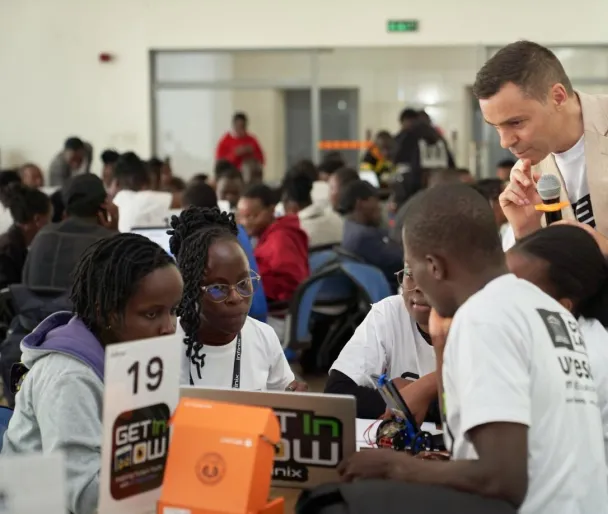Tech with heart❣️
.png)
Great design starts and ends with people. As Danu, our founder and CTO, puts it: "We are utilising technology and creating innovations using technology, but who are they for? Humans, they need to be applicable and shaped to the needs of people."
Our design process is rooted in empathy, understanding, and collaboration. We immerse ourselves in the user's world, seeking to understand their needs, motivations, and pain points. We want to give people the feels.
Recently, RUSH hosted Anijo Mathew, Dean of the Institute of Design at Illinois Tech, at our Shapeshift Salon event in Auckland. This event was part of a global series exploring the impact of Artificial Intelligence on design, democracy, and culture.
Anijo introduced the concept of the "innovation gap" - the space between technological advancement and societal needs. Anijo stressed that this is where designers must step in - and step up, using human-centred design principles to ensure that AI and other emerging technologies truly serve human needs and values.
"We're at a critical juncture where design thinking needs to evolve into design leadership… It's no longer enough to create beautiful, functional products. We need to consider the systemic impact of our designs, especially when it comes to AI."
We've seen how human-centred design significantly reduces risks across our projects at RUSH. By deeply understanding user needs and testing solutions as our projects evolve, we minimise the chances of building products that miss. As seen in our healthcare projects like The Lowdown and Starship Children's Hospital, this approach helps us navigate sensitive environments where the stakes are high.
Early user involvement and continuous feedback loops help identify potential issues before they become costly problems, whether they're safety concerns, usability barriers, or cultural misalignments. When we put people first in our design process, we ensure our solutions actually solve real human problems in ways that are meaningful and sustainable.
At RUSH we use human-centred design to drive positive change. One area where our design approach has made a significant impact is in healthcare. As highlighted in our whitepaper "Unlocking Value for Mental Health and Wellbeing with Human-Centred Design," we've seen firsthand how this approach can transform mental health services.
Tim Packer, our GM of Emerging Tech, expressed: "Digital tools are not (and can not be) a replacement for interpersonal connection - social connection is known to be a major factor that improves mental health. We should focus on digitising systems, to free up operational efficiencies so that clinicians can focus on people."
And from Rosie Alldridge, one of our Product Researchers: "With a huge dose of empathy and human-centred design methodologies, we can build solutions that put the power back in the hands of patients to drive their own personal wellbeing journey."
.png)
Our design principles have guided us when working on numerous successful projects including:
Our design principles came to life in The Lowdown, a mental wellbeing platform for rangatahi (young people) in New Zealand. We created a digital solution that truly resonated with its target audience. The result was awesome, a 500% increase in organic traffic and a 200-300% uplift in average time on page since its relaunch.
When developing CookSafe Plus for the Cook Islands government, our human-centred approach was crucial. We needed to create an interoperable contact tracing app that would work for both residents and visitors. By focusing on the unique needs of users in a tourism-dependent economy, we designed a solution that was not only effective for public health but also user-friendly and culturally appropriate. This project showcased our ability to balance technical feasibility with user needs in a complex, multi-stakeholder environment.
UNICEF Aotearoa Website Redesign
Our work with UNICEF Aotearoa demonstrates how our design principles can transform digital fundraising. We reimagined their website to create an engaging and innovative donor experience. By focusing on building empathetic connections between donors and UNICEF's work, we achieved a 476% increase in online donations. This project exemplifies our 'Valuable' and 'Emotional' design principles, creating a digital experience that encouraged donations and created a deeper connection between donors and the cause.
Starship Children's Hospital Waiting Room
In collaboration with Starship and ASB, we applied our human-centred design principles to transform the emergency department's waiting room. By understanding the needs of children, families, and staff, we created interactive experiences like the 'Starship Animal Check-Ups' and 'Magic Forest'. These innovations demonstrate our 'Considerate' principle in action, designing for inclusivity and accessibility in a high-stress environment. The result was a space that not only distracted and calmed children but also educated them about medical procedures, showcasing how design can positively impact healthcare experiences.
Continue to put people first
Our experience across different sectors shows the power of putting people first. We want to shape a future where technology enhances human experiences in meaningful and impactful ways. Read more about how we do human-centred design at RUSH here.








